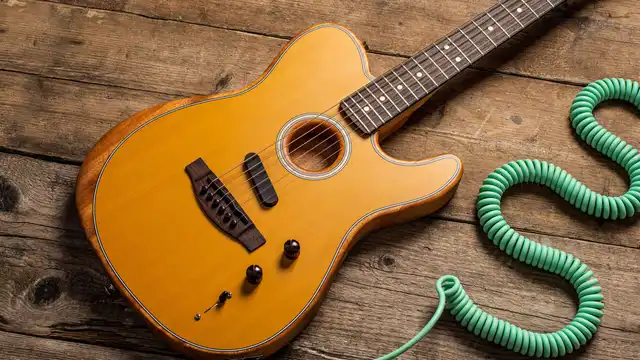Best Strings for Acoustasonic


Though Fender’s Acoustasonic guitars had some doubters when they initially came out, they have proven to be a versatile and valuable tool in the guitar arsenal of many pros. Acoustasonics have already been in the hands of people like Billy Strings, Moses Sumney, and more. Their ability to easily and conveniently shift between acoustic and electric sounds, as well as blending the two sounds together, is incredibly useful for live performances.
However, these weird and quirky guitars have also created a lot of confusion amongst their owners. What exactly are they? Are they acoustics or electrics? And most importantly, what kind of strings are you supposed to use? It is a fair question after all—they are weird guitars that are somehow halfway between an electric and an acoustic; so what strings should you use?
Well don’t worry! In this article, we are going to cover the basics of Fender’s Acoustasonic guitars, how they work, and what strings you should use for the best possible results. So keep reading to find out more about what strings are best for a Fender Acoustasonic.
Understanding the Acoustasonic
Before we delve into string choice, it’s important to understand what exactly the Acoustasonic is and how they are designed to work. First, let’s look at the general design of the guitar. Then, we’ll look more closely at the pickups and the Acoustic Engine loaded into the guitar.
General Design
At first glance, the Acoustasonic guitars look like electric guitars. Fender makes them in their classic electric guitar shapes, making them look like electric guitars. However, they are very different from a standard Strat or Tele.
Acoustasonics are essentially incredibly thin acoustic guitars. They may look and feel like standard electric guitars, but they are actually hollow and feature a soundhole like acoustics. But how does that work? Wouldn’t that just make it sound like a thin and weak acoustic guitar? Not quite.
The Acoustasonic was designed specifically to get great acoustic tones despite being more similar to an electric guitar. To accomplish this, Fender used a variety of technology and techniques in tandem, such as the custom pickups (which we’ll get to in a moment) or Fender’s String Instrument Resonance System (SIRS). When all of these parts come together, the result is a surprisingly robust and functional guitar that feels like an electric but can produce both acoustic and electric sounds.
Before moving on, it’s also important to note that despite being such a small guitar, the resonance and vibration of the top plays a huge role in the guitar's sound. The vibrations of the top are a huge factor in how the electronics work. Speaking of electronics, let’s move onto the Acoustasonic’s Acoustic Engine and Pickups.
The Acoustic Engine and Pickups
The electronics of the Acoustasonic are what really make it special. Fender used an impressive amount of modern technology to make this guitar possible. That technology also plays a huge role in string choice.
Arguably the most interesting part of this guitar is the Acoustic Engine that Fender and Fishman designed specially for the Acoustasonic. The Acoustic Engine utilizes analog and digital technology to create a selection of acoustic and electric tones.
There are five modes (electric, acoustic, enhanced harmonics, alternative acoustics, core acoustics) that can be switched between via a five way switch. They can also be blended together via the Mod Knob.
The Acousting Engine takes the analog part of the sound and utilizes digital signal processing to change the outbound signal. However, it also does more than that. The pickups also sense how the guitar’s top is vibrating and send that signal into the Acoustic Engine, so even that sound is being altered by the Acoustic Engine.
As far as the pickups go, Acoustasonics come with three pickups—A Fishman Under-Saddle Transducer, a Fishman Acoustasonic Enhancer, and a Fender Acoustasonic Noiseless magnetic pickup. Each of these pickups serves a specific purpose. The transducer allows for a classic piezo sound, the enhancer pickups the vibrations of the guitar’s top, and the magnetic pickup is for electric tones. All of these pickups were designed specifically for the Acoustasonic. They were all designed to work with acoustic strings, which will be important later.
Between the pickups and the Acoustic Engine, Acoustasonics can produce a wide variety of acoustic and electric tones, as well as blend them together for entirely unique sounds.

Best Strings for Acoustasonic
Okay, so what does all of that mean when it comes to strings? First and foremost, it means that acoustic strings are likely your best bet when it comes to the Acoustasonic. Fender designed the guitar with acoustic strings in mind, so you’ll probably get your best results with them. However, it is worth mentioning that you don’t have to use acoustic strings on an Acoustasonic.
Many players have tried using traditional electric strings on their Acoustasonics and prefer the sound/feel. According to them, electric strings make the Acoustasonic even easier to play while also thinning out the sound a bit. Depending on your preferences, that may or may not be desirable. If you want to play it more like an electric, electric strings might be a solid choice. Regardless, they are still an option if you aren’t satisfied with your current strings and want to experiment a bit. However, we generally do not recommend electric strings for the Acoustasonic.
Best Strings for Acoustasonic: Electric-leaning Players
We have two recommendations for Acoustasonic strings—one for those who want to play in a more electric style, and one for those who want it to respond more like a traditional acoustic.
For electric-style playing, we recommend our Naturals in either Extra Light (10-50) or Super Light (11-52) gauges. These strings are lighter and will give you more of an electric feel, especially paired with the slimmer neck of the Acoustasonic. However, you will still get a deep and satisfying tone since they are acoustic strings that will pair well with the Acoustasonic’s design and electronics.
If you want to go even more electric while still keeping in good tonal balance with the Acoustasonic's pickup system, try our pure nickel Broadways. These strings will give you some added flexibility and a deep, rich tone.
Best Strings for Acoustasonic: Acoustic-leaning Players
For a more acoustic feel, we recommend our Naturals in Light (12-54) or Medium (13-56) gauges. Since these strings are a more classic acoustic size, they will feel more like a traditional acoustic guitar. They will also provide a great tone when paired with the Acoustasonic.
Don't like changing strings on your Acoustasonic?
If you're looking for more longevity and a touch more brightness from your strings, our Foxwoods coated phosphor bronze acoustic guitar strings would also be an excellent option to look into. These strings feature a unique enamel coating on the wrap wire which increases peak brightness by up to 3x while preserving the feel of an uncoated string.
Conclusion
Fender’s Acoustasonic guitars are remarkably useful and powerful instruments. They can produce a wide range of sounds, all while being incredibly easy and comfortable to use. While figuring out what strings to use on them may seem confusing, we keep it simple and recommend our Natural 10s or 11s if you want to play more electric style or our Natural 12s if you want it to respond more like an acoustic. Now string it up and get picking!
Other Posts you may like

Guitar Strings Order: How the Guitar is Tuned and Why

Best Acoustic Guitar Strings for Beginners

Two Handed Tapping: Our Top 8 Tappers of All Time

Which Guitar Strings Wear Your Fret Wire Down More?

What is Nashville Tuning? Its History, Best Guitar Strings & Uses

Guitar Scale Length Explained: String Tension & Playability
0 Responses
Leave a Reply
Your email address will not be published. Required fields are marked *




